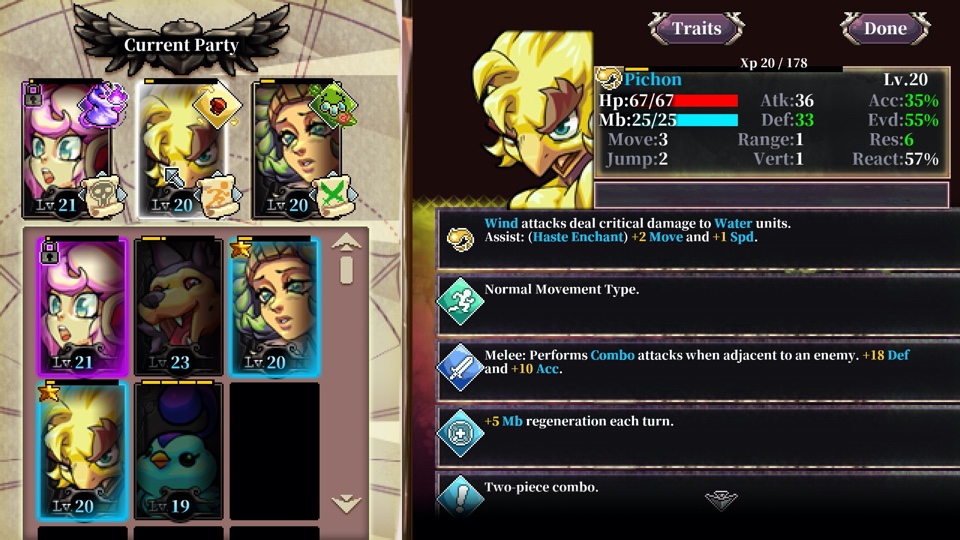Fae Tactics knows you’ve played a tactical RPG before. It knows you’re going to go all wobbly with nostalgia at a jaunty, stirring soundtrack; at a main theme that evokes Wild Arms and Fire Emblem. It knows you’re going to crack a wide smile at saucer-eyed, headstrong protagonist Peony and her pet companions. It knows that when it introduces, over a series of tutorialised intro stages, at least a dozen interplaying systems – buffs and debuffs, opposing elements, party synergy – you’re going to lap it up like the dehydrated genre aficionado you are.
You are a waiter. Fae Tactics is your manager. Fae Tactics is going to keep placing plates piled high with steaming hot systems onto your quivering arms, and just when you feel like a stray hair would send you crashing to the floor, it’s going to slap you on the back, never once fearing you might topple. As I said, Fae Tactics knows you’ve played a tactical RPG before. At least, it assumes you have.
Here’s the basics, champ; each character and enemy acts once per round based on an initiative system. You can choose to delay turns if you want. They move, then can either buff another ally, buff themselves by resting, or attack. If you attack an enemy that’s next to one or more friendly melee characters, those melee characters will attack straight afterwards, allowing you to set up powerful combos. There’s approximately sixty thousand additional systems that build on this, but that’s the core of it.

The line between engrossing complexity and unnecessary complication may seem like a thin one, but I can’t help feel that many of Fae Tactics design priorities are simply in the wrong place – stacking middling percentage modifiers where it really could have done with more overtly meaty choices. I still haven’t fully mastered a good third of what the game is doing enough to consistently make fully informed decisions, but much of this is down to me not feeling the need to. Regarding challenge, Fae Tactics seems to have two polarities. You’ll play through two or three trivially easy stages – maybe with the odd NPC you have to babysit or get autofailed into the sun – then get thrown into a war of attrition with a spongy boss that can one-shot multiple characters every few turns.
Here’s the thing though: I still quite enjoy it all, just not really for the same reasons I was expecting. It’s got a weak plot, sure, but likeable characters, and a heap of charming creature designs and great pixel art. The basic approach of setting up formations of melee, ranged, and buffer characters, augmented by cooldown-ability spells, is really quite compelling in small doses. Plus, as I said, it’s impossible to hear that soundtrack and not be transported back to a simpler time of PS1-era JRPG classics.

That’s not to say Fae Tactics doesn’t attempt to modernise either. There are no menus in combat, instead having you choose character abilities through placement, movement, and whether or not you attack that turn. There’s still a big stat and ability overlay in the top right for every character and enemy though, complete with a dizzying array of icons to display buffs, debuffs, and abilities. So, less menus doesn’t necessarily mean less reading, and it certainly doesn’t mean keeping track of less variables if you want to play optimitally.
That modernisation is also present in the art, which skews retro in sensibilities but with distinctly modern detail and dynamism. A core mechanic involves you collecting monsters – the titular Fae – to bring into battle alongside your core party, and thanks to the imaginative design work, it’s a real joy to collect some of the odder ones. Fire-puking salamanders, horned-squirrels, and Jim Henson-esque Gremlins are all there to augment your force. It’s always fun to experiment with new builds, even if they often end up feeling boxed in to quite restrictive categories in terms of applicability.

Oh, I’d better mention those Gremlins again, because one of them was pretty indicative of a real issue I have with Fae Tactics’ storytelling. I love a good David Bowie reference as much as anyone else, but when I’m fighting a boss swirling a crystal orb and quoting labyrinth before the game has bothered to really establish any of its own characters, the whole homage slips into pastiche. There’s some tantalising glimpses into the world and the lore, but much less focus into the characters or the plot itself. I’m getting weary of games that just shove a dog at me instead of working to get me invested in the characters. It is, admittedly, a very good dog though.

